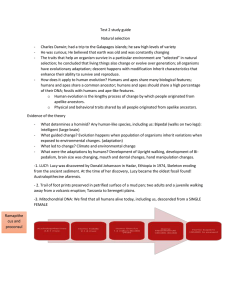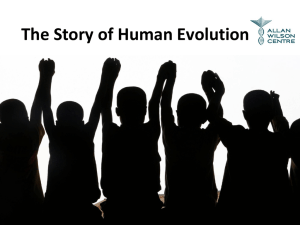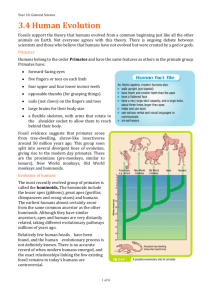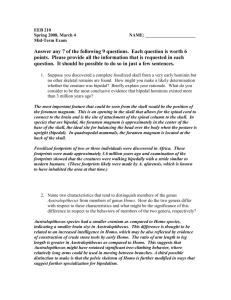Human Evolution: From Primates to Homo Sapiens
advertisement
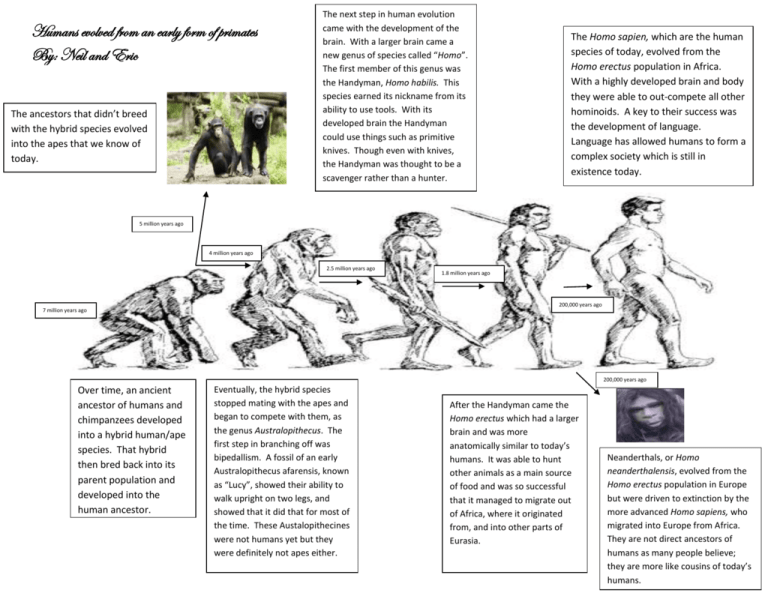
Humans evolved from an early form of primates By: Neil and Eric The ancestors that didn’t breed with the hybrid species evolved into the apes that we know of today. The next step in human evolution came with the development of the brain. With a larger brain came a new genus of species called “Homo”. The first member of this genus was the Handyman, Homo habilis. This species earned its nickname from its ability to use tools. With its developed brain the Handyman could use things such as primitive knives. Though even with knives, the Handyman was thought to be a scavenger rather than a hunter. The Homo sapien, which are the human species of today, evolved from the Homo erectus population in Africa. With a highly developed brain and body they were able to out-compete all other hominoids. A key to their success was the development of language. Language has allowed humans to form a complex society which is still in existence today. 5 million years ago 4 million years ago 2.5 million years ago 1.8 million years ago 200,000 years ago 7 million years ago 200,000 years ago Over time, an ancient ancestor of humans and chimpanzees developed into a hybrid human/ape species. That hybrid then bred back into its parent population and developed into the human ancestor. Eventually, the hybrid species stopped mating with the apes and began to compete with them, as the genus Australopithecus. The first step in branching off was bipedallism. A fossil of an early Australopithecus afarensis, known as “Lucy”, showed their ability to walk upright on two legs, and showed that it did that for most of the time. These Austalopithecines were not humans yet but they were definitely not apes either. After the Handyman came the Homo erectus which had a larger brain and was more anatomically similar to today’s humans. It was able to hunt other animals as a main source of food and was so successful that it managed to migrate out of Africa, where it originated from, and into other parts of Eurasia. Neanderthals, or Homo neanderthalensis, evolved from the Homo erectus population in Europe but were driven to extinction by the more advanced Homo sapiens, who migrated into Europe from Africa. They are not direct ancestors of humans as many people believe; they are more like cousins of today’s humans. Other theories have described the theory of human evolution as a straight line from apes to humans. This theory is similar to ours as it has many of the genus’s and species evolving at the correct moments in time and in the right order. This is shown through how the Australopithecus comes before the Homo habilis which comes before the Homo erectus. However, this theory is incorrect in saying that it was a straight line from the Homo erectus to the Neanderthal to the Homo sapien. This theory says the Neanderthal was a direct ancestor of modern day humans when it was actually a cousin of today’s humans. It also does not account for how apes and humans split apart into different species in the first place, as the hybridization of ancient apes does in our theory. Sources Cited Gifs images from googleimages.com - http://www.mentallyjumbled.com/wp-content/uploads/2010/07/human-evolution.gif http://static.howstuffworks.com/gif/chimp-2.jpg - http://newsimg.bbc.co.uk/media/images/40811000/jpg/_40811817_mockup250.jpg http://churchofcriticalthinking.org/images/missinglinkdebate.jpg - http://humanorigins.si.edu/evidence/human-evolution-timeline-interactive http://evolution-101.blogspot.com/2006/05/how-did-humans-evolve.html



